In this white paper, we present a comprehensive approach for successful omnichannel implementation and provide an easy to follow guide for large scale omnichannel enablement. We will start off by looking at what omnichannel is and some of its pitfalls, and go on to explain how to best enable omnichannel on a large-scale, enterprise level.
Executive Summary
An omnichannel presence is vital for retailers in today’s landscape. Having the proper framework and infrastructure to support it is just as important. Scalable systems with adaptable back-ends provide companies with the flexibility they need for anything from massive growth to technology advances, to everything in between. The implementation of an Order Management System that has cross-channel visibility and adequately addresses your logistical and fulfillment needs, is also essential. The consistency your customers experience in your stores and across all channels only serves to make their shopping experience easier and more enjoyable, building trust and loyalty.
Introduction
For today’s retailer, an omnichannel presence is non-negotiable in order to provide a seamless customer-centric buying experience. However, for many large organizations, omnichannel has come to mean a hodgepodge of duct-taped front and back-end solutions that produce anything but a seamless experience. This paper will provide an easy to follow guide for large scale omnichannel enablement by sharing a comprehensive approach for successful implementation.
Why Omnichannel?
Shopping is no longer confined by space and time. With the advent of smart devices, social media, and innovative apps, customers can browse and shop whenever, wherever, and on whatever device they like. This has changed the game for retailers. Consumers are more educated on shopping and fulfillment options than ever before, and in addition to competitive pricing and a broad range of products, they expect a feature-rich and seamless shopping experience. We’ve seen what happens when retailers fail to embrace omnichannel. Blockbuster’s exclusive focus on physical stores failed to acknowledge the burgeoning eCommerce marketplace, and as a direct consequence, Netflix drove them out of business. By contrast, Amazon constantly reinvents itself. The company has introduced Amazon Lockers, same-day shipping and delivery, has started using drones to compete with the brick and mortar advantage of physical retailers, and has even opened a flagship store in Manhattan - a resounding validation of the omnichannel approach. In the modern business world, retailers must embrace a comprehensive approach, that incorporates all potential sales channels, in order to remain competitive.
Doing the Right Things is as Important as Doing Things Right
While most retailers know omnichannel is critical for the longevity of their business, very few know how to plan, execute, and implement a successful strategy. When a customer wants a product, the path to that product must be short, readily available, and consistently support the brand promise. As a result, omnichannel is often viewed exclusively as a front-end strategy for customers across a variety of touchpoints (e.g., providing a find-in-store or reserve-in-store feature on your website). What’s often overlooked is that fulfilling customer needs across multiple channels do not occur in a vacuum by implementing and upgrading customer touchpoints. In fact, attempting to enable front-end functionalities without a robust and scalable technology platform will lead to increased operational costs, customer dissatisfaction and reduced revenue. Failing to upgrade a rigid platform can easily lead to supply chain nightmares and, at the very least, will hinder future business agility. A truly seamless shopping experience depends on the back-end operations and technology that drives the supply chain, order management system and fulfillment behind the scenes.
Omnichannel EcoSystem
In order to aid retailers with implementing a comprehensive omnichannel approach, we’ve drawn upon our decades of experience in working with large-scale retailers to design an omnichannel ecosystem composed of five key foundation blocks:
-
Consolidated Product Catalog
-
Cross-Channel Inventory Visibility
-
Fulfillment & Logistics
-
Distributed Order Management
-
360° Customer Insight
Each block is made up of two essential components: the adaptable back-end system and API economy (also known as Omni-API)
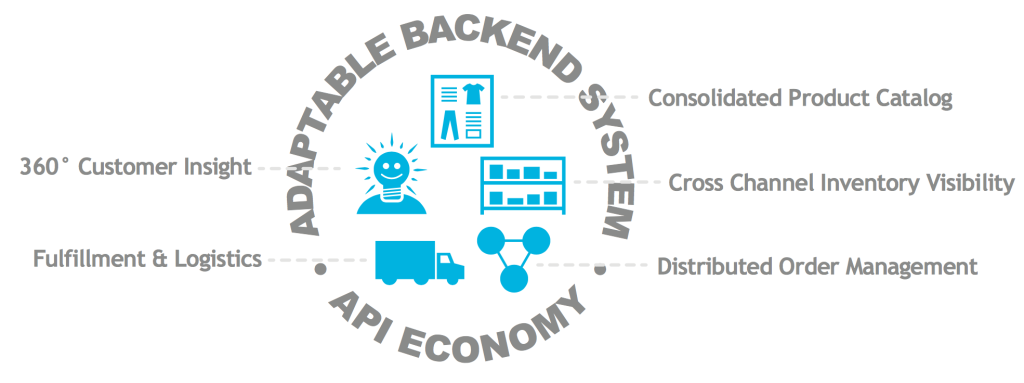
Adaptable Backend System
An adaptable back-end system focuses on building robust and scalable software architecture and technology stack for back-end systems that drives omnichannel efforts. This increases agility by effectively addressing architecture and technology bottlenecks with a particular focus on specific retail sub-domains such as Catalog and Inventory.
API Economy
The growing demand for omnichannel capabilities has accelerated the organizational need to adopt and implement adaptable back-end systems at the core of operations. This requires application programming interfaces (APIs) to universally access an organization’s core systems and resources within or outside the organization. The API economy represents a new and already market-proven way of doing business that is flexible, powerful, and capable of on-demand integration with almost any external system. The traditional retail dichotomy of store versus site is not sophisticated enough to compete in today’s economy. With the advent of new marketplaces and the explosion of mobile apps, businesses must be ready to integrate new possibilities with minimal disruption, whether they choose to implement in-app Apple Pay, promote through Groupon, or create an Instagram collection store à la Target Awesome Shop. API Economy is a path to future readiness for retailers and exemplifies just how much APIs can positively impact an organization’s profitability. In the following sections, we’ll explore each of these foundation blocks in detail:
Consolidated Product Catalog
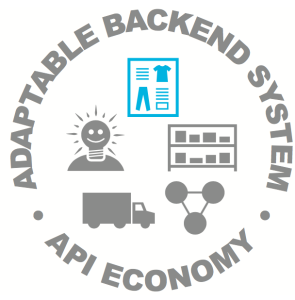
Product attributes have never played a more fundamental role in the retail industry. Product information has evolved with the expansion of eCommerce and social media; prior to online retailing, product attributes for a traditional brick and mortar store consisted of UPC, color, size, product ID, and product description. With the advent of eCommerce, product attributes have evolved to allow for more efficient searches, and now include far more customer-centric attributes such as, care information, fabric information, place of manufacture, quantity at hand, return description, shipping description, product image, product video, and consumer reviews. When shopping online, consumers have come to expect robust product information to assist them in making an informed decision. Product data is the connective tissue of retail and can be used to augment nearly every area of a business, including customer acquisition, merchandising demand planning, operations, warehousing, and transportation. Most retailers have product information for their eCommerce channel set up separately from their brick and mortar channel and, because of the number of attributes added to the product information on eCommerce channels, consumers are now often equipped with more product knowledge than the average store associate. Traditional product management systems were not designed to include a complex set of information for a product, so retailers and suppliers tended to exchange a finite set of data through their legacy catalogs. However, sharing product data is one of the foundations of providing a more comprehensive shopping experience for consumers, no matter where they choose to shop. Retailers need a single catalog, irrespective of the sales channel in question.
General challenges:
-
A limited attribute set which does not allow for the addition of customer-friendly - attributes as products evolve
-
Tightly integrated systems can restrict modifications of the product catalog due to their ripple effect on downstream systems
-
Separate databases for online and store catalogs means that any change will result in discrepancy or require a significant investment
Adaptable Back-End System
Everyone feels the pain when integrating multiple data sources, but it is a necessary step to provide a true omnichannel experience. It is crucial to have an adaptable backend system that can not only handle today’s demand for a seamless omnichannel experience but also properly position a retailer for future success. A large number of retailers now prefer to use NoSQL, either as a data store or for analytics purposes. By keeping a single product ID and maintaining the rest of the product information (both in-store and online) as attributes, a retailer can easily work within the ecosystem of the NoSQL database. The existing systems that a supplier or product owner uses to create new products and content via content management systems can easily be leveraged to integrate with the database and enhance the legacy systems with rich product attributes. This results in a single, consolidated product catalog within the back-end system that remaining systems can leverage.
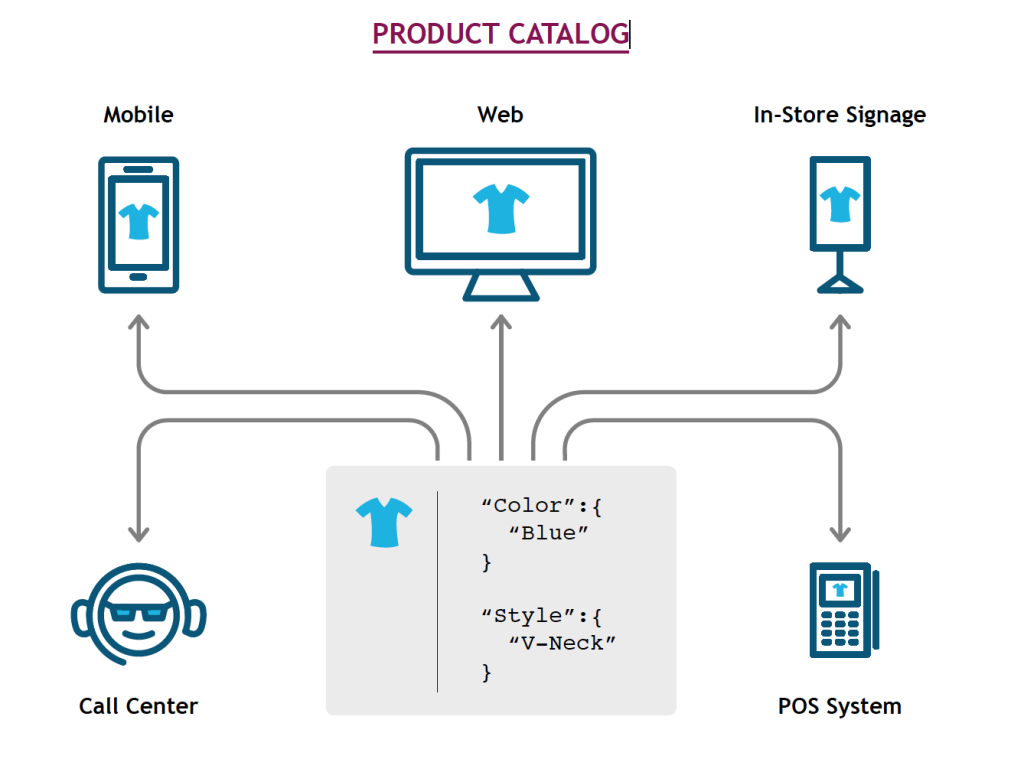
API Economy
With the help of API Economy, retailers are not only able to sell products on their own websites, but also partner with websites such as eBay, Target, and Best Buy. Leveraging existing systems, third parties are able to call the same set of APIs used by retailer websites. The look and feel of the partnering website mirrors their own website, making social commerce just one more area where retailers can benefit from APIs. Having an omnichannel Lookup API that can access the new catalog and return information about a product (including its availability, price at the store/online, and any applicable promotions) empowers consumers. It provides them with the ability to, for example, easily determine if the desired item is available at a nearby store for pick-up, or if it would be more convenient to have it shipped. Store associates are now better equipped to provide a more personalized customer experience by recommending the right product for the customer.
Cross Channel Inventory Visibility
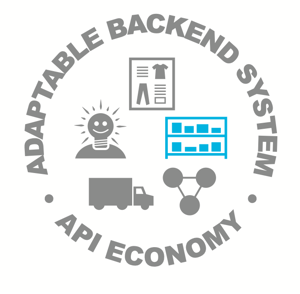
Now that consumers have the ability to shop for an item through any one of a number of available channels, retailers must be able to immediately provide an item’s inventory status, i.e. availability and location, making inventory status a primary attribute for every product. While traditional product information systems were not designed to handle inventory and location, in today’s world, this data is crucial for a timely delivery. To effectively compete for consumers’ business, retailers must now have control of both real-time inventory and rich product information. The consequences of poor inventory management can be devastating. Retailers routinely cancel online orders because a product reads as out of stock, only to find they still have the product at their physical stores. Cross-channel inventory addresses this, but unfortunately, most retailers still have a dedicated inventory for each channel as a byproduct of implementing eCommerce domains after having physical stores.
General Challenges
-
Channels suffer from an inaccurate view of product inventory status, resulting in canceled orders and loss of revenue
-
Separate warehouse systems are maintained, resulting in inventory that is not visible across all channels
-
Inventory systems are transaction-sensitive, as a result, any change incurs a significant risk
Adaptable Back-End System
Adaptable Back-End System Maintaining a cross-channel inventory requires a scalable and robust back-end system that can provide inventory information to any platform – online, mobile or brick and mortar. At most enterprises, inventory is broken down in three ways:
-
Warehouse Management Systems (WMS) - inventory in distribution centers
-
Point of Sale (POS) - inventory on the shelves on stores
-
Enterprise Resource Planning (ERP) - inventory in the supply chain
The idea is to consolidate inventory from these disparate systems into a single data store that provides a comprehensive, enterprise view of inventory in near real-time. Ideally, organizations should have a consolidated product catalog prior to integrating cross-channel inventory in order to ensure that every channel is aligned with the same product data. Sharing inventory details across channels becomes seamless as there is no need to map different product IDs against the associated inventory statuses. Inventory becomes one more attribute in the product catalog and can be leveraged to use the existing NoSQL database without redesigning from scratch.
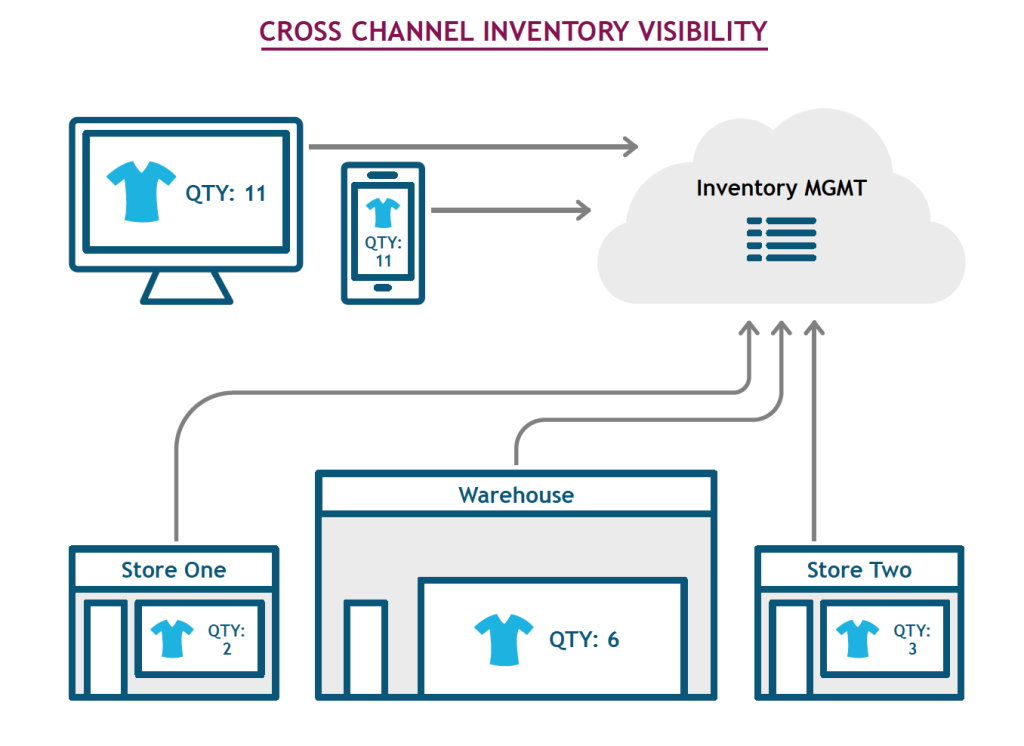
Maintaining cross-channel inventory will empower retailers to leverage advanced analytics to predict future demand, based on past performance, and easily create a breakdown of products sold at various channels by region. Cross-channel inventory sharing opens up the doors for a host of powerful omnichannel features, including find-in-store, ship-from-store, and order-in-store.
API Economy
If your cross-channel inventory is visible across channels and systems, it can be exposed as APIs, encouraging easier partnerships with retail market places and social media platforms. If a consolidated product catalog is already in place, inventory status can be exposed as well, resulting in the same product status across internal channels and external marketplaces.Distributed Order Management
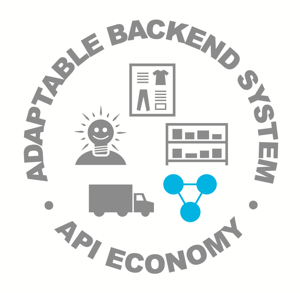
A distributed order management system (OMS) is an eCommerce engine responsible for managing information, executing processes, and monitoring performance to ensure customer orders are fulfilled accurately and cost-effectively across a complex network of sourcing and fulfillment processes. Key capabilities of the system include intelligent order sourcing, multichannel support, global inventory visibility, real-time order execution, and demand sensing for greater responsiveness to customer behavior. It delivers consistent functionality across channels so that consumers can use the same promotions, shipping choices, and other functions, without worrying about whether or not a specific feature is supported on a given channel (e.g., mobile).
General Challenges
-
Delays in order processing and delivery
-
Incomplete visibility of products across all channels
-
Lack of inventory visibility across channels from OMS
-
Inconsistent feature support across channels
-
Optimized sourcing, particularly ship-from-store and item transfer planning
-
Lack of communication on backorders and out-of-stock items during peak periods
Adaptable Back-End System
Because OMS plays a critical role in order processing, it needs to be scalable to customer demand. OMS functions should also be accessible across channels so that the system can act as a centralized order orchestration hub, going beyond channel-specific processing. Cloud-based technologies can be employed to horizontally scale OMS, and ideally, should have the ability to scale selected modules horizontally somewhere in the line of micro-services. In most businesses, demand for the order-creation module is higher than that for the order-cancellation module, i.e., a business may need ten instances of order-creation but only two instances of order cancellation, rather than ten instances of each. Often OMS databases are heavily loaded and very sensitive as they are high on writes and reads. Nisum best practices suggest partitioning databases by brand, month, or some other parameter, which boosts performance tremendously to improve the overall order processing experience. Businesses must also contend with harsh consequences when dealing with sourcing changes. Having the ability to implement order-sourcing logic through a metric-driven configuration gives them the flexibility to tune order sourcing to customer demand, season, and other parameters.
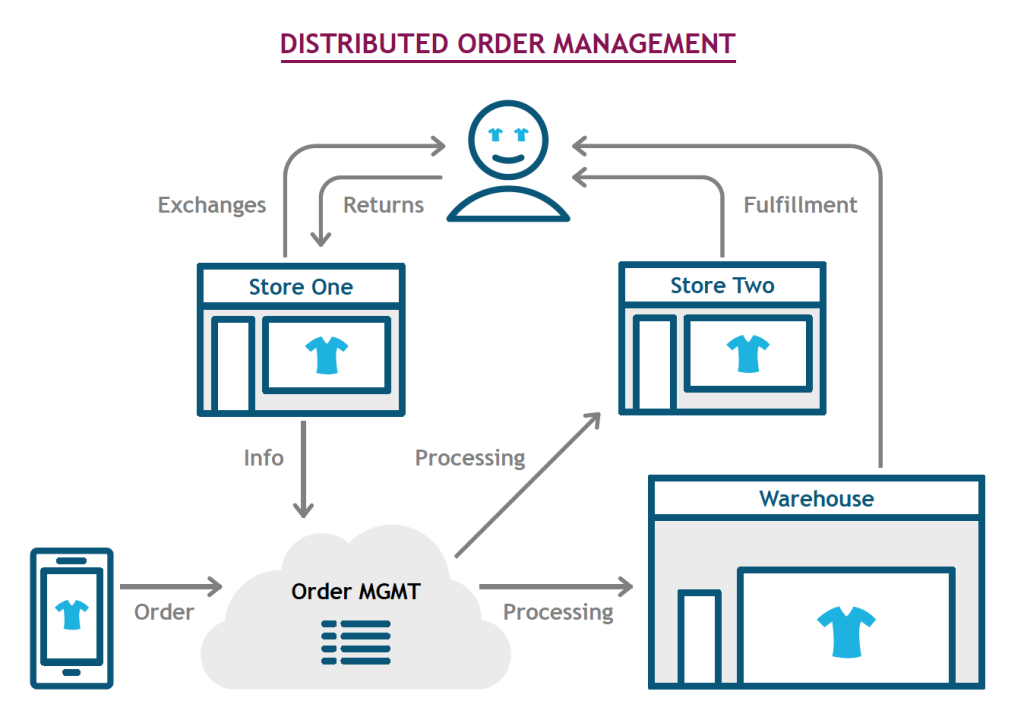
API Economy
With their cross-channel integration capabilities, distributed order management solutions provide store associates with visibility into available-to-promise inventory at eligible fulfillment locations. They also indicate the optimal location from which the product should be replenished, and whether it should be shipped, held for pickup, or transferred. Standard APIs also provide the ability to integrate with existing in-store point of sale systems. Finally, the distributed order management system can trigger the appropriate notifications to the designated replenishment locations, maintaining comprehensive order status visibility throughout the process.
Fulfillment & Logistics
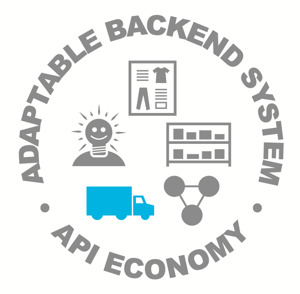
In a traditional supply chain, retailers order items from vendors, vendors ship them to the distribution centers (DCs), and the DCs ship them to stores as needed. Under this model, whenever a retailer opens a new channel, such as eCommerce, they would use a completely different supply chain model. Online orders were fulfilled from a separate DC in order to avoid a complicated integration with their traditional model. This resulted in degraded customer experience between channels, duplicated processes, and unavailable inventory information at the DCs. Because channels were isolated, retailers were often unable to meet their required demands.
General Challenges
-
Split inventory means maintaining multiple warehouses and inventory sets, as well as the additional warehouse staff needed to maintain them
-
Additional costs for shipping inventory between warehouses can become necessary
-
Adding new fulfillment options such as ordering online for in-store pick up, or purchasing in-store for home delivery is a massive undertaking
-
Peak-season demand is difficult to manage
Adaptable Back-End System
There is a huge disconnect between existing back-end systems and the real needs of today’s retailers. The rapid increase in fulfillment alternatives brought on by technological and behavioral advances has made legacy back-end system architectures obsolete and exposed retailers’ failure to support fulfillment complexity. Instead of building isolated processes and infrastructures that do not scale for unanticipated requirements, organizations need an adaptable back-end system that supports dynamic fulfillment requirements. Omnichannel fulfillment must be carefully engineered so that retailers can hold just the right amount of inventory on a wide assortment of products, ensuring the right store receives the right inventory, at the right time. When a customer orders an item, it is important to weigh the logistical benefits of either fulfilling the order at the store or from a DC. Retailers must walk a fine line between missing an order due to out-of-stock items and ordering too much inventory that must be sold at a discount due to overstock. These days, consumers expect near-realtime home delivery, and the key to being able to deliver on that expectation is having a WMS solution that allows for complex slotting to allow a granular understanding of the costs associated with fulfilling orders by SKU, by the customer, and by channel. WMS is a way to improve DCs and store-level inventory accuracy, and expand support for omnichannel features including order online/pickup in-store, order online/deliver from the store, and order online/return in-store.
API Economy
The fulfillment software used in one DC is often different from that used in another DC, and different still from that used in-stores. As a result, each channel yields data in its own format, which is often incompatible with data from other streams. In order to create an omnichannel data stream that allows near real-time events to be captured across fulfillment centers and stores, communication must be standardized across different applications. Exposing APIs from such discrete systems not only eases cross-system integration, it also enables real-time consolidated reporting and predictive analytics.
360° Customer Insight
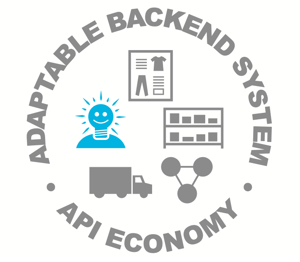
Omnichannel commerce has put customer insight at the center of the process, and retailers are eager to use these new tools to provide more customizable customer solutions. On the other hand, consumers want the ability to engage with the retailer via a variety of channels, as well as the freedom to pick up where they left off on one channel and continue on another. From another perspective, technology has made it possible for companies to collect massive amounts of information about the consumer. It is now possible to examine a customer’s browsing patterns, past shopping history, buying behavior, social media interactions, and channel preference – and that is only the beginning. In today’s marketplace, companies need to maintain a 360° view of their customers and leverage that data to provide customers with more seamless customer experience. In order to achieve this, customer information must be integrated from multiple communication channels, as well as customer communication from disparate sources: telephone, email, social media, and live chat, to name a few. Getting the data together is only half the challenge; just as important is properly interpreting that data and using it to make the right decisions. A comprehensive customer profile can now be derived by linking customer transaction histories, interaction histories, and insights gathered from across retailers’ multiple brands, business units, and channels. Combined with syndicated data in the form of demographics, gender, discretionary income, etc., this data provides the retailer with an extremely detailed picture of a customer’s buying potential, lifestyle, preferred product lines, and even sensitivity toward price ranges.
General Challenges
-
Lack of insight into customer preferences and shopping patterns
-
Inability to provide localized or personalized experiences to customers
-
Lack of access to consolidated account information and other data for products
Adaptable Back-End System
The advent of Big Data-based listening and sentiment mining allows customer reviews to be analyzed at a whole new level of granularity and clarity. Now that it is possible to read millions of conversations taking place simultaneously across multiple channels, customer insights can be combined with a customer’s core profile to provide an enhanced understanding of customer behavior. Harvesting useful insights from such a holistic knowledge repository open new frontiers for customer engagement and improvement of the shopping experience. A powerful set of analytical tools built on top of the customer capture repository will allow retailers to infuse customer insights into their merchandising, marketing, eCommerce, mobile, and social processes, and open up newer features such as more relevant product recommendations, localized assortment of products in-store, and targeted marketing campaigns.
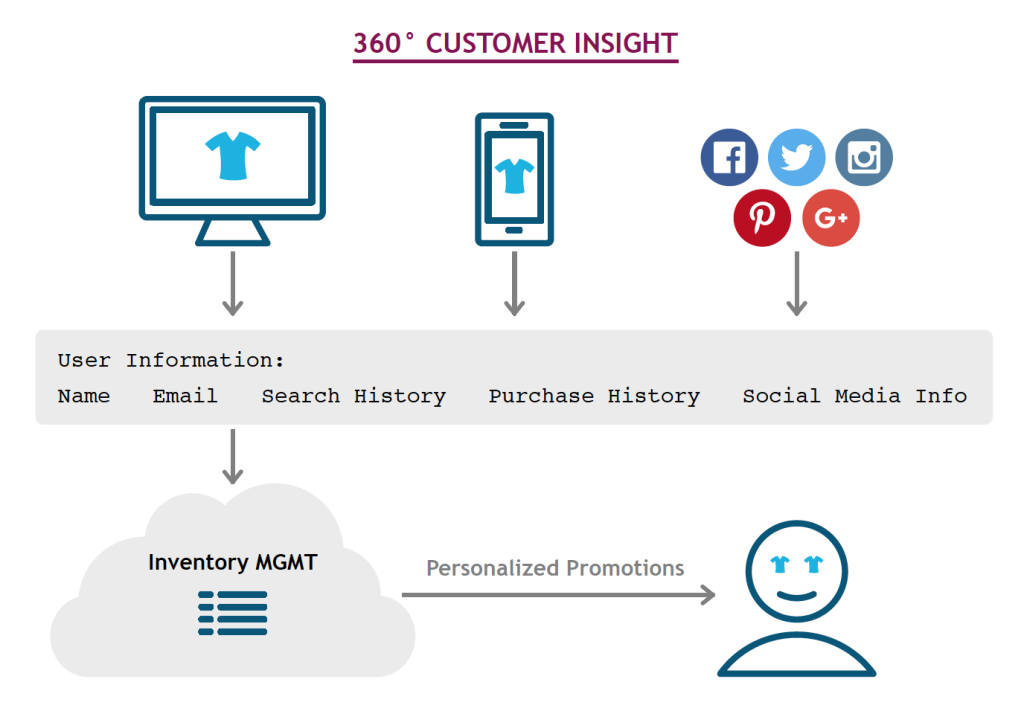
API Economy
Providing an API that facilitates data accessibility and customer information can help retailers deliver product content and ads that are customized for each customer and focused on user experience. Moreover, the use of external-facing APIs can effectively expose your business as a service to any consuming app, in any of your business channels. Whether it be your main web portal, your iOS or Android app, or the POS in your physical store - the decision to centralize IT automations in web APIs bridges channel gaps so that all touch points contribute to the experience your customers demand while affording you a 360º view of their transactions.
Conclusion
Consumer expectations and the demands of modern business have made it clear that omnichannel is critical to success. However, rushing into implementation blindly can land you in a complicated and expensive situation, leading to counterproductive results and the inability to meet rising demand. Rather than taking a front-end driven approach, retailers should embrace a holistic view, align front-end priorities with back-end needs, and work to create a long-lasting application platform that is agile in implementation and built to meet current and future business requirements. Incorporating years of research and experience, Nisum’s omnichannel ecosystem allows retailers to take that comprehensive approach.



